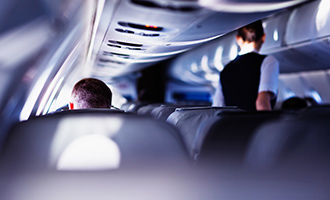Need Help?

The concerns of Cabin Safety go beyond the safety demonstration before a flight. It encompasses a range of different disciplines, topics and processes which are not always evident to airline customers.
Indeed, the role of cabin crew is varied - but all tasks are carried out with a focus on safety. Cabin safety is about preventing injury, and preventing the escalation of an abnormality into an emergency.
Cabin Safety is a vital part of any safety management system (SMS). It ensures that the cabin product and service is designed and delivered to the customer as safely as possible. Because of this, the role of a Cabin Safety professional involves risk management, training, reporting, investigation, auditing, fatigue risk management, formulating safety and emergency procedures and more.
Onboard safety is everyone's responsibility. To help ensure your flight is safe and trouble free, please read our passenger safety information card (pdf) to see how to store your bag correctly and to keep your electronic devices safe inflight.
Need Help?
The safe carriage of lithium batteries and portable electronic devices remains a safety issue for airlines. Please see our passenger information to ensure that you carry these safely when you travel.
For more information on checked and carry-on baggage, see our travelers and IATA pages.
Items containing lithium batteries, explosives, gases, flammable liquids or solids, peroxides, poisons, corrosives and magnets may be dangerous when carried by air. If you intend to travel with anything in these categories, such as camping equipment, medical devices, mobility devices, etc. please our Passenger Dangerous Goods corner for advice.
Cabin Operations Safety Best Practices Guide
The ninth edition of the IATA Cabin Operations Safety Best Practices Guide, published in January 2024 is the central reference for industry-agreed best practices, procedures and regulations for safe and efficient cabin operations.
The guide also offers valuable benchmarks for airline management to set up their own corporate procedures and training programs for cabin crew and gives comprehensive guidance to support the IATA Operational Safety Audit (IOSA) standards relating to cabin operations. Obtain the cabin operations safety guide now.
Best practices guide for cabin retrofit and entry into service program
This guidance has been created by collaboration with Engineering and Maintenance specialists and aims to ensure that Cabin Safety operational risk is included within a cabin layout design or change program. It includes program management guidance as well as raises awareness of many of the risks involved in the introduction of a new cabin.
Best practices guide - Cabin interior retrofits and EIS (pdf)
The IATA Cabin Operations Safety Task Force (COSTF) members are an important link between IATA and the operational environment. The Task Force comprises of up to 15 IATA airline members from around the world who are actively involved in all aspects of cabin safety including:
- Cabin operations and procedures
- Cabin Crew Training
- Accident and/or Incident Investigation
- Human Factors
- Quality Assurance
The COSTF are responsible for updating IOSA standards and IATA's Guidance materials, along with identifying emerging safety risks, contributing to risk assessment processes and contribute to the IATA World Safety and Operations Conference (WSOC).
For further information or to comment on any of the guidance material, please contact Cabin Safety.
IATA is committed to providing airlines with the necessary and up to date information to address emerging risks and share best practices to support them in risk management activities.
Cabin risks already identified are included in the IATA Safety Issue Hub.
IATA Safety Connect
In order to help us identify new and emerging risks, and to facilitate discussions among airline Cabin Safety professionals aimed at helping them mitigate cabin safety risks, we ecourage safety professionals within airlines to register to join the IATA Safety Connect site.
This valuable resource allows airlines to participate in group discussions and share knowledge or concerns relating to emerging risks, policies, procedures, equipment, incidents and investigations. It also contains various detailed cabin safety risk assessments aimed at helping airlines understand and manage cabin risk more effectively.
Please note that membership is restricted to airlines only and company email accounts must be used for registration.
During the Covid-19 pandemic, IATA published multiple guidance documents to help airlines adapt to the ever changing circumstances and challenges faced. As restrictions have now eased significantly around the world and travel is returning to normal, these guidance materials have been archived and removed from these pages. The recommendations included are discretionary and may, or may not be incorporated by airlines as appropriate to their specific area of operation.
Airline safety teams who have subscribed to IATA Safety Connect can download these archived guidance documents from the Cabin Safety pages within IATA Safety Connect.